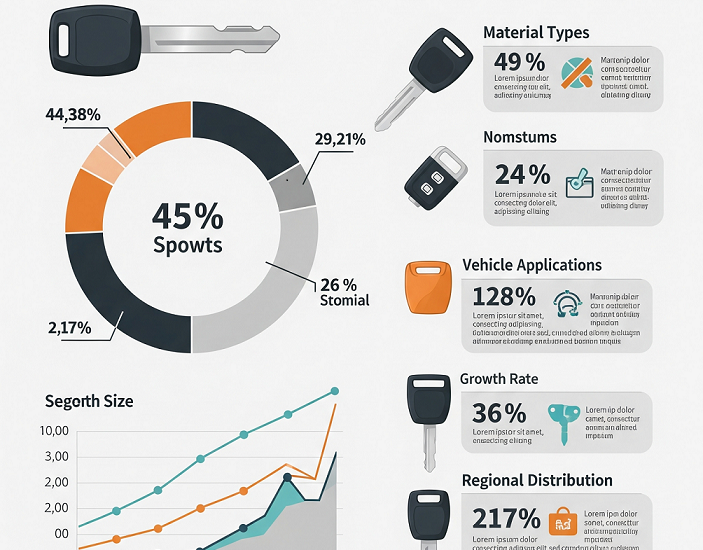The automotive key blank market is valued at USD 6.48 billion in 2025 and is slated to reach USD 10.21 billion by 2035, at a compound annual growth rate (CAGR) of 4.65%. This growth is driven by the increasing production of vehicles globally, coupled with the rising demand for advanced automotive key systems.
In a world racing toward keyless entry, biometric ignition, and app-based vehicle control, the humble automotive key blank seems like a relic of the past. But look closer, and it becomes clear that this unassuming component still plays a critical, if quiet, role in the global mobility ecosystem.
It may not buzz with tech or light up dashboards, but the key blank remains a vital piece of automotive infrastructure—bridging legacy systems, aftermarket services, and security protocols. As vehicles grow smarter, the need for secure, reliable, and adaptable access solutions only grows more complex—and key blanks are adapting right along with them.
Get Ahead with Our Report: Request Your Sample Now!
https://www.futuremarketinsights.com/reports/sample/rep-gb-8204
More Than Metal: The Hidden Architecture of Access
Key blanks are far more than simple mechanical tools. Modern iterations include transponder chips, RFID tags, and encrypted coding surfaces—making them hybrid devices that serve both physical and digital authentication roles. They’re not just cut to shape; they’re programmed to communicate with a vehicle’s electronic control systems.
As vehicles blend mechanical and electronic security layers, key blanks must match this sophistication. That means supporting remote start functions, immobilizer systems, and even integration with mobile apps. The result? A simple-looking object that’s actually the first handshake between user and machine.
Overshadowed by Smart Keys, Rooted in Necessity
Push-button starts and digital keycards may dominate the headlines, but not every vehicle on the road is a rolling server. A vast portion of the global fleet still depends on physical keys—especially in emerging markets, commercial fleets, and the aftermarket repair ecosystem.
Whether it’s duplicating a lost key, replacing a damaged fob, or integrating a programmable blank into an aging ignition system, these components are essential to daily vehicle use. They provide a cost-effective, scalable access solution that doesn’t require cloud updates or subscription fees.

Security, Scalability, and Simplicity
While OEMs push innovation at the luxury end of the market, locksmiths, dealerships, and fleet operators need tools that are versatile, tamper-resistant, and compatible across multiple models. Automotive key blanks deliver on that need with evolving technologies that balance simplicity with secure programmability.
The industry is also navigating tighter vehicle theft regulations and stricter data access laws. As a result, key blanks are now engineered to meet higher encryption standards and more stringent manufacturing tolerances—without sacrificing ease of use or availability.
A Critical Link in the Aftermarket Chain
Key blanks are a lifeline for the automotive aftermarket, enabling quick-turn repairs, fleet maintenance, and dealership services without the need to replace entire lock systems. Specialized cutting and coding tools, increasingly automated and software-driven, allow technicians to serve diverse customer needs at scale.
This adaptability makes the key blank a vital part of mobility infrastructure—especially in regions where internet connectivity is inconsistent or full digital integration is still years away. It’s not just about convenience; it’s about resilience in global vehicle access.
Exhaustive Market Report: A Complete Study
https://www.futuremarketinsights.com/reports/automotive-key-blanks-market
Where Legacy Meets Innovation
As connected vehicles multiply, the role of access hardware is shifting—but not disappearing. The next generation of key blanks is being designed with dual-use capabilities, supporting both traditional ignition and encrypted wireless signals. Some even integrate biometric sensors or NFC tags, blending mechanical durability with high-tech function.
This convergence signals a new purpose for the key blank—not as a legacy artifact, but as a flexible, secure point of interaction between old and new automotive systems.
The Unseen Guardian of Everyday Mobility
The automotive key blank doesn’t dominate dashboards or make headlines in CES showcases. But it continues to quietly ensure that millions of vehicles stay accessible, operable, and secure. In a world fixated on high-tech transformation, it remains a grounding force—proving that even the smallest components can have lasting importance.
Ignore the key blank, and you risk breaking the continuity between legacy and innovation. Invest in its evolution, and you unlock not just doors, but the full spectrum of accessible, adaptable mobility—across models, markets, and generations.


